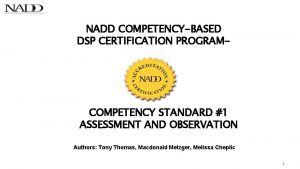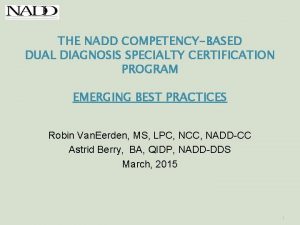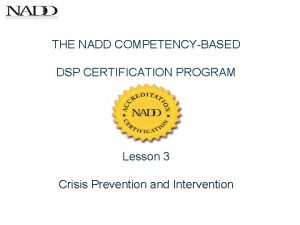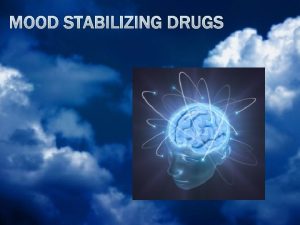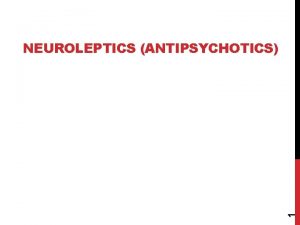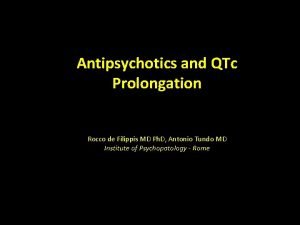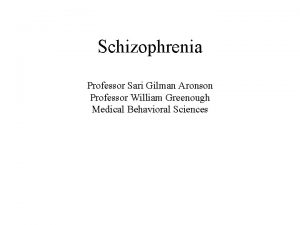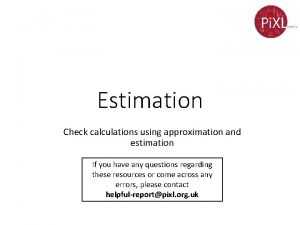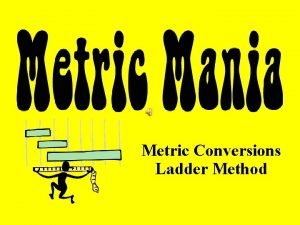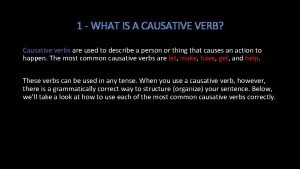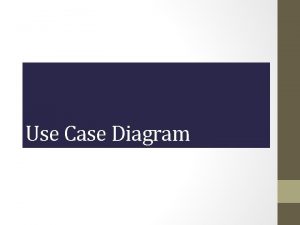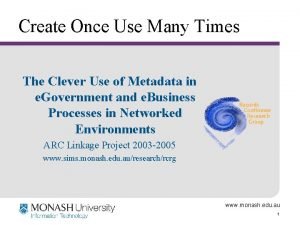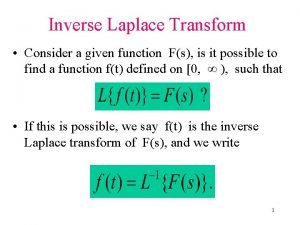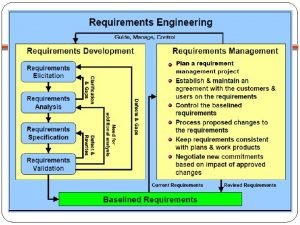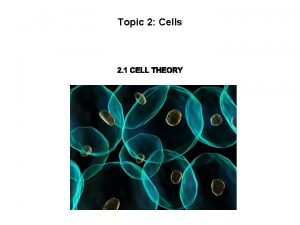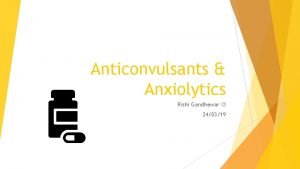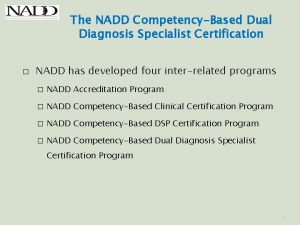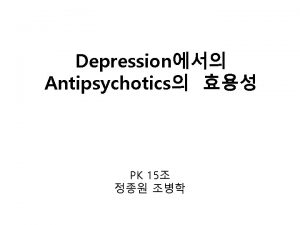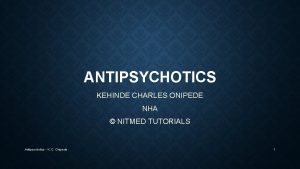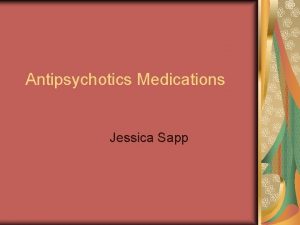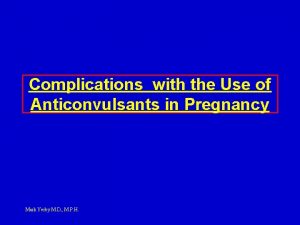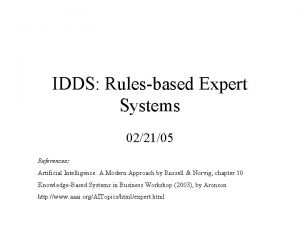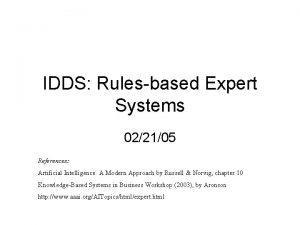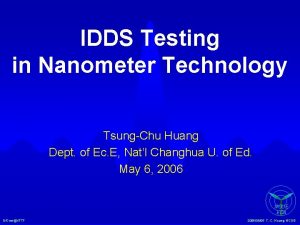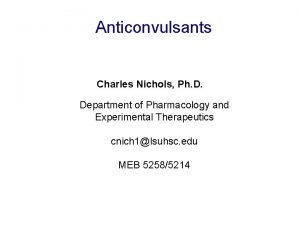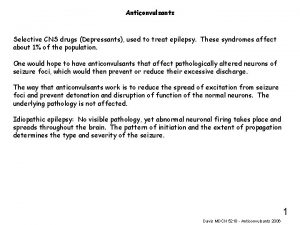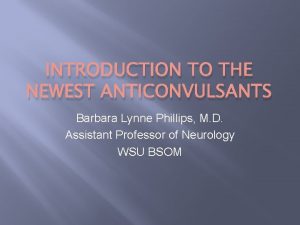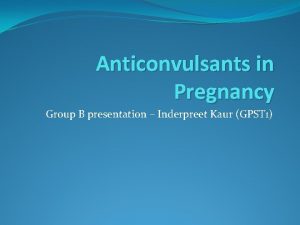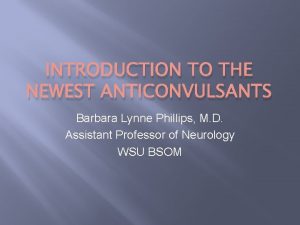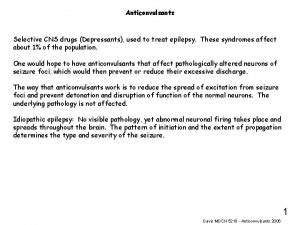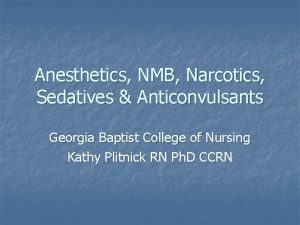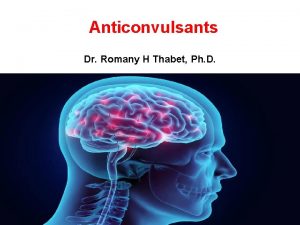The Use of Antipsychotics Anticonvulsants in IDDs NADD



























































































- Slides: 91

The Use of Antipsychotics & Anticonvulsants in IDDs NADD 34 rd Annual Conference- November 3, 2017 Joseph L. Calles, Jr. , M. D. Department of Psychiatry WMU Homer Stryker M. D. School of Medicine

Professional Information § Associate Professor of Psychiatry, Western Michigan University Homer Stryker M. D. School of Medicine, Kalamazoo, MI § Consultant, Great Lakes Center for Autism Treatment and Research, Portage, MI § Board Certified in General and Child & Adolescent Psychiatry § Member, American Academy of Child & Adolescent Psychiatry § Member, NADD

Disclosure § There are no financial affiliations or compensations related to the content of this presentation.

Medications Discussed § Antipsychotics: § § § aripiprazole (Abilify®, Aristada®) asenapine (Saphris®) brexpiprazole (Rexulti®) cariprazine (Vraylar®) clozapine (Clozaril®, Faza. Clo®, Versacloz®) iloperidone (Fanapt®) lurasidone (Latuda®) olanzapine (Zyprexa®) paliperidone (Invega®) quetiapine (Seroquel®) risperidone (Risperdal®) ziprasidone (Geodon®)

Medications Discussed § Anticonvulsants: § § § acetazolamide (Diamox®) brivaracetam (Briviact®) carbamazepine (Tegretol®, Carbatrol®, Equetro®) clobazam (Onfi®) divalproex sodium (Depakote®) eslicarbazine (Aptiom®) ethosuximide (Zarontin®) ezogabine (Potiga®) fosphenytoin (Cerebyx®) felbamate (Felbatol®) gabapentin (Neurontin®) lacosamide (Vimpat®)

Medications Discussed § Anticonvulsants (cont. ): § § § lamotrigine (Lamictal®) levetiracetam (Keppra®) methsuximide (Celontin®) oxcarbazepine (Trileptal®) perampanel (Fycompa®) pregabalin (Lyrica®) phenytoin (Dilantin®, Phenytek®) rufinamide (Banzel®) tiagabine (Gabitril®) topiramate (Topamax®, Qudexy XR®, Trokendi XR®) vigabatrin (Sabril®) zonisamide (Zonegran®)

Presentation Overview 1. 2. 3. 4. 5. 6. 7. Epidemiology of psychopathology in IDDs Epidemiology of epilepsy in IDDs Epidemiology of psychopathology in epilepsy The intersection of IDDs, MI and epilepsy Pharmacotherapy of psychopathology in IDDs Pharmacotherapy of epilepsy in IDDs Pharmacotherapy of psychopathology in epilepsy

Presentation Overview 8. Pharmacotherapy of combined IDD, MI and epilepsy 9. Potential adverse events, drug-drug interactions, and proconvulsant effects in the treatment of comorbid disorders

Epidemiology of Psychopathology in IDDs

Epidemiology of Psychopathology; General § One study examined rates of behavior problems and psychopathology among children with DDs compared to both chronologic age (CA) and mental age (MA) matched comparison groups. § Significant group differences were found for ADHD, most notably the inattentive subtype, which was over three times as prevalent in the DD group. In the MA-match analyses, the DD group demonstrated significantly higher rates of the hyperactive subtype. § The prevalence of Social Phobia was significantly higher in the DD than the typical development sample for the MA-match analyses. Caplan, et al. , 2015

Caplan, et al. , 2015

Epidemiology of Psychopathology: General § A UK study found that more than a third- 40. 9% (clinical diagnoses) or 35. 2% (DC–LD diagnoses)of an adult, ID cohort had mental ill-health. § Those point prevalence rates were higher than those observed in the UK general population. Cooper, et al. , 2007 c

Cooper, et al. , 2007 c

Epidemiology of Psychopathology: Selfinjurious Behavior § A UK study found the point prevalence of selfinjurious behavior (SIB) to be 4. 9%, the 2 -year incidence 0. 6%, and the 2 -year remission rate 38. 2%. § At any point in time, the point prevalence of SIB was accounted for by both new onset, and by enduring SIB, with enduring SIB predominating. Cooper, et al. , 2009 a

Epidemiology of Psychopathology: Aggressive Behavior § The same UK group found the point prevalence of aggressive behavior was 9. 8%, 2 -year incidence was 1. 8%, and, for the adults who had aggressive behavior, the 2 -year remission rate was 27. 7%. § Prevalence was accounted for by both new onset aggressive behavior and enduring aggressive behaviors. Cooper, et al. , 2009 b

Epidemiology of Psychopathology: Psychosis § Cooper’s group found the point prevalence of psychosis to be 2. 6%-4. 4% depending upon the diagnostic criteria used; 2 -year incidence of psychotic episode was 1. 4%, 2 -year incidence of first episode of psychosis was 0. 5%, and, of people in episode at entry, the remission rate in the 2 -year period was low, at 14. 3%. Cooper, et al. , 2007 a

Epidemiology of Psychopathology: Mood Disorders § Cooper’s group also found that the point prevalence of affective (mood) disorders was higher in the ID population (than that reported previously for the general population): 3. 8% for depression and 0. 6% for mania. § In addition, 1. 0% had bipolar disorder, currently in remission, and 0. 1% first episode of mania, currently in remission. Cooper, et al. , 2007 b

Epidemiology of Epilepsy in IDDs

Epidemiology of Epilepsy in IDDs § A review article reported that in general samples of people with IDs, the pooled estimate (from 38 studies) of epilepsy prevalence was 22. 2%. § For samples of people with Down syndrome, excluding two studies focusing on older people, the prevalence rate was lower, with the pooled estimate (from 11 studies) being 10. 3%. Robertson, et al. , 2015

Epidemiology of Epilepsy in IDDs § A systematic review of outcomes in ASDs found that the overall percentage of participants with epilepsy at follow-up ranged between 1. 8% in those under 12 years of age (the majority of whom did not have an ID) and 23. 7% of those over 12 years of age, of whom the majority did have an ID. § These are significantly greater percentages than those reported in the literature for the general population, but are similar to those found for IDs. Woolfenden, et al. , 2012

Epidemiology of Epilepsy in IDDs § The causes of IDDs and epilepsy are increasingly recognized to be genetic, based on: chromosomal microarray analysis to identify copy number variants; gene panels; and, whole-exome sequencing. § A specific genetic diagnosis may guide care by pointing to comorbid disorders and best therapy. Devinsky, et al. , 2015

Examples of recurrent copy number variants associated with ID, epilepsy, and other neurodevelopmental phenotypes

Examples of recurrent copy number variants associated with ID, epilepsy, and other neurodevelopmental phenotypes

Epidemiology of Epilepsy in IDDs § The prevalence of epilepsy increases with the severity of the IDD. Among 692 patients with childhood-onset epilepsy followed for 20 -30 years, 147 (21%) had IDD with epilepsy. Of those 147 cases, 53% had severe/profound IDD compared to 24% with moderate IDD and 24% with mild IDD. Devinsky, et al. , 2015

Epidemiology of Epilepsy in IDDs § Seizure type is also influenced by the severity of the IDD. Focal epilepsies predominate in those with mild IDD (69%; 17% with symptomatic generalized epilepsy), similar to those with normal intelligence, while symptomatic generalized epilepsies predominate in those with severe IDD (67%; 29% with focal epilepsy). § Seizure type is related to rates of remission, with some types being more treatment-resistant. Devinsky, et al. , 2015

Devinsky, et al. , 2015

Epidemiology of Psychopathology in Epilepsy

Epidemiology of Psychopathology in Epilepsy § In the task force report from the International League Against Epilepsy (ILAE), the authors note that epidemiological studies in a number of different countries, and over a long period of time, have yielded reasonably consistent results with regard to the rates of psychiatric disorder in children with epilepsy, which have ranged from around 35% to 50%. Sillanpää, et al. , 2016

Epidemiology of Psychopathology in Epilepsy § ADHD is under-diagnosed and under-treated in children with epilepsy. Approximately 30% of children with epilepsy have ADHD. § There is a broad differential diagnosis for the causes of ADHD symptoms in children with epilepsy, including the epilepsy itself and some antiepileptic drugs. Besag, et al. , 2016 b

Epidemiology of Psychopathology in Epilepsy § Anxiety and depression are common in children and adolescents with epilepsy, affecting onequarter to one-third of patients. § Multiple epilepsy-related, psychological and genetic -familial factors have been implicated in causing anxiety and depression in patients with epilepsy. Dunn, et al. , 2016

Epidemiology of Psychopathology in Epilepsy § The overall research evidence suggests that schizophrenia-like psychosis is believed to be 6 to 12 times more likely to occur in people with epilepsy than in the general population. § Although many of these are brief, peri-ictal psychotic states, others are a longer lasting, interictal psychosis. Mendez, et al. , 1993

The Intersection of IDDs, MI, and Epilepsy

The Intersection of IDDs, MI, and Epilepsy § The previously cited ILAE task force report also noted that the prevalence of psychiatric disorder in children with complicated epilepsy, usually implying accompanying intellectual disability, is much higher, well over 50%. Sillanpää, et al. , 2016

The Intersection of IDDs, MI, and Epilepsy § In another study, investigators looked at: (a) associations between epilepsy (or epilepsy-related factors) and neuropsychiatric comorbidities in patients with ID and (b) between ID and neuropsychiatric comorbidities in patients with epilepsy. van Ool, et al. , 2016

The Intersection of IDDs, MI, and Epilepsy § There was an indication that having epilepsy was significantly related to higher rates of negative mood symptoms in adults and elderly with ID, including depressive symptoms, negative mood, and mood swings. Having epilepsy was, however, not associated with emotional disturbances. Most studies also did not demonstrate a significant association between the presence of epilepsy and behavioral problems van Ool, et al. , 2016

The Intersection of IDDs, MI, and Epilepsy § Generally, the results indicated that more severe epilepsies (including generalized seizures), greater seizure severity, higher seizure frequency, and higher number of seizure types, were risk factors for behavioral problems and psychiatric disorders. van Ool, et al. , 2016

The Intersection of IDDs, MI, and Epilepsy § Having ID was related to higher rates of ASD, postictal psychosis, and both psychotic and nonpsychotic disorders. § The degree of the ID seemed relevant with respect to behavioral problems, a more severe ID being significantly associated with more behavioral problems in adults with epilepsy. van Ool, et al. , 2016

Summary of findings on neuropsychiatric outcomes in patients with ID and epilepsy van Ool, et al. , 2016

Factors contributing to the genesis and persistence of psychiatric disorders in patients with IDDs and epilepsy Devinsky, et al. , 2015

Pharmacotherapy of Psychopathology in IDDs

Pharmacotherapy of SIB § In the UK, an expert panel’s (all 258 consultant members on the mailing list of the Royal College of Psychiatrists’ Learning Disability Faculty) first choices of medications for SIB were: q q q Antipsychotics- 49. 1% Antidepressants- 25. 9% Anti-anxiety drugs- 11. 1% Unwin & Deb, 2008

Pharmacotherapy of SIB § The expert panel’s first choices of atypical antipsychotics for SIB were: q q q Risperidone- 74. 1% Olanzapine- 12. 0% Quetiapine- 0. 9% Unwin & Deb, 2008

Pharmacotherapy of SIB § The expert panel’s first choices of antidepressants for SIB were: q q Citalopram- 32. 4% Fluoxetine- 22. 2% Sertraline- 11. 1% Escitalopram- 9. 3% Unwin & Deb, 2008

Pharmacotherapy of Aggression § In the UK, an expert panel’s (all 258 consultant members on the mailing list of the Royal College of Psychiatrists’ Learning Disability Faculty) first choices of medications for aggression were: q q q Antipsychotics- 80. 6% Anti-anxiety drugs- 12. 0% Antidepressants- 6. 5% Unwin & Deb, 2008

Pharmacotherapy of Aggression § The expert panel’s first choices of atypical antipsychotics for aggression were: q q q Risperidone- 78. 7% Olanzapine- 13. 0% Quetiapine- 1. 9% Unwin & Deb, 2008

Pharmacotherapy of Aggression § The expert panel’s first choices of antidepressants for aggression were: q q Citalopram- 35. 2% Fluoxetine- 19. 4% Sertraline- 13. 0% Escitalopram- 10. 2% Unwin & Deb, 2008

Pharmacotherapy of Psychosis § Any antipsychotic medication can be used to treat psychotic symptoms in individuals with IDDs, with the atypical agents being preferred over older agents. § The choice of agent will be determined by the trade -off between efficacy and tolerance (side effect profile).

Pharmacotherapy of Mood Disorders § The selective serotonin reuptake inhibitors (SSRIs) are the preferred medications for the treatment of depression in individuals with IDDs. § The atypical antipsychotics are first line treatments for bipolar disorder/mania, unless there is comorbid epilepsy, in which case anticonvulsants with good mood stabilizing properties should be used first.


Pharmacotherapy of Epilepsy in IDDs

Pharmacotherapy of Epilepsy in IDDs § Therapy to control seizures should be individualized, with drug selection based on seizure types, epilepsy syndrome, concomitant medications, and comorbid disorders. § There are limited comparative antiepileptic drug data in the IDD with epilepsy population. Devinsky, et al. , 2015

Pharmacotherapy of Epilepsy in IDs § A Cochrane Review on pharmacological interventions for epilepsy in people with IDs determined that, in general, AEDs that are proven to be effective in the general epilepsy population are also effective for refractory epilepsy in people with ID. § It was not possible for the authors to comment on the relative efficacy of medications, making clinical decisions difficult. Jackson, et al. , 2015

Pharmacotherapy of Epilepsy in IDs § The treatment of refractory epilepsy does seem to differ if IDs are present. § A Canadian study found that patients with ID were currently taking, and had been previously exposed to, a greater number of different AEDs. Patients with ID were also more likely to be taking at least one older AED and were more commonly treated with benzodiazepines. Fridhandler, et al. , 2012

Pharmacotherapy of Epilepsy in IDs § A more recent study assessed the efficacy of newer AEDs in individuals with Angelman syndrome (AS) (~80%-90% with AS have epilepsy). § Newer AEDs, such as levetiracetam, lamotrigine, and clobazam, and, to a lesser extent, topiramate, appeared to be as effective- if not more so- as valproic acid and clonazepam, while offering more favorable side effect profiles. Shaaya, et al. , 2016

Pharmacotherapy of Epilepsy in IDs § Another genetic syndrome with high prevalence of epilepsy (up to 90%) is tuberous sclerosis complex (TSC). § A Dutch study of children with TSC and epilepsy found that vigabatrin was used by 94% of children, and was the first treatment in 48%. § Vigabatrin was more effective than other AEDs (including VPA) when prescribed as first treatment. Overwater, et al. , 2015

Pharmacotherapy of Psychopathology in Epilepsy

Pharmacotherapy of Psychopathology in Epilepsy § A previously cited article noted that about 70% of children with ADHD and epilepsy will benefit from standard treatment, such as methylphenidate. § To date, there appears to be no firm evidence that the usual treatments for ADHD are likely to exacerbate seizures. Besag, et al. , 2016 b

Pharmacotherapy of Psychopathology in Epilepsy § Although studies of treatments for depression and anxiety, in populations with epilepsy, are limited, another article cited previously commented that SSRIs and cognitive behavioral therapy (CBT) are currently accepted treatments. § The SSRIs and the SNRIs do not reduce seizure threshold, and may even lessen the chance of seizures. Dunn, et al. , 2016

Pharmacotherapy of Psychopathology in Epilepsy § The AED pregabalin has been recommended as a first-choice treatment for generalized anxiety disorder in adults with epilepsy, but no data exists for treatment of children with anxiety and epilepsy. Mula, 2016

Pharmacotherapy of Psychopathology in Epilepsy § If psychosis is not drug-induced and requires antipsychotic treatment, it should not normally be withheld on the basis of possible seizure exacerbation (see the last section of this presentation). § For postictal psychosis, the antipsychotic treatment can be withdrawn slowly when the psychotic features have resolved, but further antipsychotic treatment might be required if there are future episodes. Besag, et al. , 2016 a

Pharmacotherapy of Psychopathology in Epilepsy § Psychosis in association with the prescription of some antiepileptic drugs can also occur in children and adolescents. § If the psychosis is drug-induced, a review of the antiepileptic medication is indicated. (see the last section of this presentation). Besag, et al. , 2016 a

Pharmacotherapy of Combined IDD, MI and Epilepsy

Pharmacotherapy of Combined IDD, MI and Epilepsy § There are no studies that specifically address the treatment of individuals with this clinical triad. § Some experts have made recommendations for AED selections in those with IDDs and epilepsy. § Given that several AEDs are also used to treat psychiatric disorders, suggested AEDs can be considered as first or second choices to treat epilepsy and some comorbid psychiatric disorders in individuals with IDDs: Shankar, et al. , 2016

Making a treatment choice: initial treatment

Making a choice: monotherapy failure

Pharmacotherapy of Combined IDD, MI and Epilepsy § The use of AEDs is better-suited to treat bipolar disorder, less so for some anxiety and depressive disorders, and not for psychotic disorders (unless they derive from the epilepsy itself). § Other classes of psychotropic medications can be used in individuals with the clinical triad, but must be used cautiously to avoid drug-drug interactions and other adverse effects.

Potential Adverse Events, Drug-Drug Interactions, and Proconvulsant Effects in the Treatment of Comorbid Disorders

Adverse Events § The previously cited ILAE task force reported on adverse cognitive and behavioral effects of AEDs in children. § They distinguished the older AEDs from the newer, and newest, AEDs. § A striking finding was the lack of information on children. Aldenkamp, et al. , 2016

Adverse Events § The authors surmised that there may be negative cognitive effects with phenobarbital, phenytoin, topiramate and zonisamide. § Adverse behavioral effects were associated with phenobarbital, valproate, gabapentin, topiramate, levetiracetam and zonisamide. Aldenkamp, et al. , 2016

Adverse Events § With regard to cognitive effects, valproate, carbamazepine (CBZ), gabapentin and oxcarbazepine appear to be neutral. § CBZ appears to be neutral with regard to behavioral effects. § Positive cognitive effects have been reported with lamotrigine (LTG) and levetiracetam. § Positive behavioral effects have been reported with LTG. Aldenkamp, et al. , 2016

Adverse Events § Although the data on adolescents with psychosis is somewhat limited, there seems every reason to recommend starting at low doses and escalating the dose slowly when AEDs that have a documented association with psychosis, such as vigabatrin and topiramate, are being prescribed. Besag, et al. , 2016 a

Recommendations for use of antiepileptic drugs in children, based on cognitive and behavioral complications Note: Lined-out drugs not available in the US Aldenkamp, et al. , 2016

Making a choice: Considering adverse events

Making a choice: Considering adverse events

Adverse Events § A study that evaluated the use of the newer AED perampanel in patients with ID and epilepsy found that behavioral adverse effects were present in 40. 3%. Most common were aggression, agitated behavior, disruptive behavior, and mood symptoms. Snoeijen-Schouwenaars, et al. , 2017

Kennedy, et al. , 2013

AED and antipsychotic drug-drug interactions (Derived from Epocrates)

AED and antipsychotic drug-drug interactions (Derived from Epocrates)

Proconvulsant Effects: Antipsychotics Wu, et al. , 2016

Proconvulsant Effects: Antipsychotics Wu, et al. , 2016

Conclusions § Individuals with combined IDDs, epilepsy and psychiatric disorders are complex and difficult to treat. § AEDs can have adverse cognitive and behavioral effects. § Some psychotropic medications can increase the risk of seizure activity.

Conclusions § There are no medications that treat the underlying, core features of IDDs, so the focus of treatment is controlling seizure activity and reducing psychiatric symptoms. § Initial treatment should target the most distressing and/or impairing symptoms. § Use of medications should follow the “start low, go slow” approach.

Conclusions § Try to use the least number of medications, choosing agents that can serve more than one function, e. g. , AEDs that are also good mood stabilizers. § It is a safe assumption that any clinical deterioration in patients on medications could be from the medications themselves, including side effects (e. g. , constipation or urinary retention).

Questions?

References Aldenkamp A, Besag F, Gobbi G, Caplan R, Dunn DW, Sillanpää M. Psychiatric and Behavioural Disorders in Children with Epilepsy (ILAE Task Force Report): Adverse cognitive and behavioural effects of antiepileptic drugs in children. Epileptic Disord 2016; 18(S 1): S 55 S 67. Besag F, Caplan R, Aldenkamp A, Dunn DW, Gobbi G, Sillanpää M. Psychiatric and Behavioural Disorders in Children with Epilepsy (ILAE Task Force Report): Epilepsy and psychosis in children and teenagers. Epileptic Disord 2016 a; 18(S 1): S 31 -S 36. Besag F, Gobbi G, Caplan R, Sillanpää M, Aldenkamp A, Dunn DW. Psychiatric and Behavioural Disorders in Children with Epilepsy (ILAE Task Force Report): Epilepsy and ADHD. Epileptic Disord 2016 b; 18(S 1): S 8 -S 15. Caplan B, Neece CL, Baker BL. Developmental level and psychopathology: comparing children with developmental delays to chronological and mental age matched controls. Res Dev Disabil 2015; 37: 143 -51.

References Cooper SA, Smiley E, Allan LM, Jackson A, Finlayson J, Mantry D, et al. Adults with intellectual disabilities: prevalence, incidence and remission of self-injurious behaviour, and related factors. J Intellect Disabil Res 2009 a; 53(3): 200 -216. Cooper SA, Smiley E, Jackson A, Finlayson J, Allan L, Mantry D, et al. Adults with intellectual disabilities: prevalence, incidence and remission of aggressive behaviour and related factors. J Intellect Disabil Res 2009 b; 53(3): 217 -232. Cooper SA, Smiley E, Morrison J, Allan L, Williamson A, Finlayson J, et al. Psychosis and adults with intellectual disabilities: Prevalence, incidence, and related factors. Soc Psychiatry Psychiatr Epidemiol 2007 a; 42(7): 530 -536. Cooper SA, Smiley E, Morrison J, Williamson A, Allan L. An epidemiological investigation of affective disorders with a population-based cohort of 1023 adults with intellectual disabilities. Psychol Med 2007 b; 37(6): 873 -882. Cooper SA, Smiley E, Morrison J, Williamson A, Allan L. Mental ill-health in adults with intellectual disabilities: prevalence and associated factors. Br J Psychiatry 2007 c; 190(1): 27 -35.

References Devinsky O, Asato M, Camfield P, Geller E, Kanner AM, Keller S, Kerr M, Kossoff EH, Lau H, Kothare S, Singh BK, Wirrell E. Delivery of epilepsy care to adults with intellectual and developmental disabilities. Neurology 2015; 85(17): 1512 -21. Dunn DW, Besag F, Caplan R, Aldenkamp A, Gobbi G, Sillanpää M. Psychiatric and Behavioural Disorders in Children with Epilepsy (ILAE Task Force Report): Anxiety, depression and childhood epilepsy. Epileptic Disord. 2016; 18(S 1): S 24 -S 30. Fridhandler JD, Coelho FM, Tai P, Jette N, Andrade DM. A comparison of antiepileptic drug therapy in patients with severe intellectual disability and patients with normal intellect. Epilepsy Behav 2012 Oct; 25(2): 196 -9. Habibi M, Hart F, Bainbridge J. The impact of psychoactive drugs on seizures and antiepileptic drugs. Curr Neurol Neurosci Rep 2016; 16(8): 71. Jackson CF, Makin SM, Marson AG, Kerr M. Pharmacological interventions for epilepsy in people with intellectual disabilities. Cochrane Database Syst Rev 2015; 9: CD 005399.

References Kennedy WK, Jann MW, Kutscher EC. Clinically significant drug interactions with atypical antipsychotics. CNS Drugs 2013; 27(12): 1021 -48. Mendez MF, Grau R, Doss RC, Taylor JL. Schizophrenia in epilepsy: seizure and psychosis variables. Neurology 1993; 43(6): 1073 -1077. Mula M. Treatment of anxiety disorders in epilepsy: an evidence-based approach. Epilepsia 2013; 54(Suppl 1): 13 -8. Overwater IE, Bindels-de Heus K, Rietman AB, Ten Hoopen LW, Vergouwe Y, Moll HA, de Wit MC. Epilepsy in children with tuberous sclerosis complex: Chance of remission and response to antiepileptic drugs. Epilepsia 2015; 56(8): 1239 -45. Robertson J, Hatton C, Emerson E, Baines S. Prevalence of epilepsy among people with intellectual disabilities: A systematic review. Seizure 2015; 29: 46 -62.

References Shaaya EA, Grocott OR, Laing O, Thibert RL. Seizure treatment in Angelman syndrome: A case series from the Angelman Syndrome Clinic at Massachusetts General Hospital. Epilepsy Behav 2016; 60: 138 -41. Shankar R, Doran Z, Kerr M. The use of antiepileptic medication in adults with intellectual disabilities: A serious conundrum. In: Prasher VP, Kerr M, eds. Epilepsy and Intellectual Disabilities, Second Edition. Springer International Publishing, 2016. Sillanpää M, Besag F, Aldenkamp A, Caplan R, Dunn DW, Gobbi G. Psychiatric and Behavioural Disorders in Children with Epilepsy (ILAE Task Force Report): Epidemiology of psychiatric/behavioural disorder in children with epilepsy. Epileptic Disord 2016; 18(S 1): S 2 -S 7. Snoeijen-Schouwenaars FM, van Ool JS, Tan IY, Schelhaas HJ, Majoie MH. Evaluation of perampanel in patients with intellectual disability and epilepsy. Epilepsy Behav 2017; 66: 64 -67.

References Unwin GL, Deb S. Use of medication for the management of behavior problems among adults with intellectual disabilities: a clinicians' consensus survey. Am J Ment Retard 2008; 113(1): 1931. van Ool JS, Snoeijen-Schouwenaars FM, Schelhaas HJ, Tan IY, Aldenkamp AP, Hendriksen JG. A systematic review of neuropsychiatric comorbidities in patients with both epilepsy and intellectual disability. Epilepsy Behav 2016; 60: 130 -7. Woolfenden S, Sarkozy V, Ridley G, Coory M, Williams K. A systematic review of two outcomes in autism spectrum disorder - epilepsy and mortality. Dev Med Child Neurol 2012; 54(4): 306 -12. Wu CS, Wang SC, Yeh IJ, Liu SK. Comparative risk of seizure with use of first- and secondgeneration antipsychotics in patients with schizophrenia and mood disorders. J Clin Psychiatry 2016; 77(5): e 573 -9.

Additional References Brodie MJ, Besag F, Ettinger AB, Mula M, Gobbi G, Comai S, Aldenkamp AP, Steinhoff BJ. Epilepsy, antiepileptic drugs, and aggression: an evidence-based review. Pharmacol Rev 2016; 68(3): 563 -602. Kimura G, Kadoyama K, Brown JB, Nakamura T, Miki I, Nisiguchi K, Sakaeda T, Okuno Y. Antipsychotics-associated serious adverse events in children: An analysis of the FAERS database. Int J Med Sci 2015; 12(2): 135 -40. Piedad J, Rickards H, Besag FMC, Cavanna AE. Beneficial and adverse psychotropic effects of antiepileptic drugs in patients with epilepsy: A summary of prevalence, underlying mechanisms and data limitations. CNS Drugs 2012; 26(4): 319 -335. Spina E, Hiemke C, de Leon J. Assessing drug-drug interactions through therapeutic drug monitoring when administering oral second-generation antipsychotics. Expert Opin Drug Metab Toxicol. 2016; 12(4): 407 -22. Weintraub D, Buchsbaum R, Resor SR Jr, and Hirsch LJ. Psychiatric and behavioral side effects of the newer antiepileptic drugs in adults with epilepsy. Epilepsy Behav 2007; 10(1): 105 -110.
 Nadd dsp certification
Nadd dsp certification Nadd certification
Nadd certification Nadd dsp certification
Nadd dsp certification Lithium mechanism of action
Lithium mechanism of action First gen antipsychotics
First gen antipsychotics Neurolyptics
Neurolyptics Thorazine qtc prolongation
Thorazine qtc prolongation Antipsychotics brain damage
Antipsychotics brain damage Các châu lục và đại dương trên thế giới
Các châu lục và đại dương trên thế giới Từ ngữ thể hiện lòng nhân hậu
Từ ngữ thể hiện lòng nhân hậu Diễn thế sinh thái là
Diễn thế sinh thái là Vẽ hình chiếu vuông góc của vật thể sau
Vẽ hình chiếu vuông góc của vật thể sau Ng-html
Ng-html Thế nào là giọng cùng tên
Thế nào là giọng cùng tên Phép trừ bù
Phép trừ bù Lời thề hippocrates
Lời thề hippocrates Hươu thường đẻ mỗi lứa mấy con
Hươu thường đẻ mỗi lứa mấy con Tư thế worm breton là gì
Tư thế worm breton là gì đại từ thay thế
đại từ thay thế Quá trình desamine hóa có thể tạo ra
Quá trình desamine hóa có thể tạo ra Công thức tính độ biến thiên đông lượng
Công thức tính độ biến thiên đông lượng Thế nào là mạng điện lắp đặt kiểu nổi
Thế nào là mạng điện lắp đặt kiểu nổi Dot
Dot Biện pháp chống mỏi cơ
Biện pháp chống mỏi cơ Bổ thể
Bổ thể Vẽ hình chiếu đứng bằng cạnh của vật thể
Vẽ hình chiếu đứng bằng cạnh của vật thể Phản ứng thế ankan
Phản ứng thế ankan Các môn thể thao bắt đầu bằng tiếng đua
Các môn thể thao bắt đầu bằng tiếng đua Thiếu nhi thế giới liên hoan
Thiếu nhi thế giới liên hoan Khi nào hổ con có thể sống độc lập
Khi nào hổ con có thể sống độc lập Hát lên người ơi alleluia
Hát lên người ơi alleluia điện thế nghỉ
điện thế nghỉ Một số thể thơ truyền thống
Một số thể thơ truyền thống Trời xanh đây là của chúng ta thể thơ
Trời xanh đây là của chúng ta thể thơ Số.nguyên tố
Số.nguyên tố Tia chieu sa te
Tia chieu sa te Tỉ lệ cơ thể trẻ em
Tỉ lệ cơ thể trẻ em Các châu lục và đại dương trên thế giới
Các châu lục và đại dương trên thế giới Thế nào là hệ số cao nhất
Thế nào là hệ số cao nhất ưu thế lai là gì
ưu thế lai là gì Hệ hô hấp
Hệ hô hấp Tư thế ngồi viết
Tư thế ngồi viết Cái miệng xinh xinh thế chỉ nói điều hay thôi
Cái miệng xinh xinh thế chỉ nói điều hay thôi Hát kết hợp bộ gõ cơ thể
Hát kết hợp bộ gõ cơ thể đặc điểm cơ thể của người tối cổ
đặc điểm cơ thể của người tối cổ Cách giải mật thư tọa độ
Cách giải mật thư tọa độ Tư thế ngồi viết
Tư thế ngồi viết Voi kéo gỗ như thế nào
Voi kéo gỗ như thế nào Thẻ vin
Thẻ vin Thể thơ truyền thống
Thể thơ truyền thống Yesterday
Yesterday Make sentences using the pictures and the words
Make sentences using the pictures and the words Present continuous and past continuous tense
Present continuous and past continuous tense Would rather in negative form
Would rather in negative form Use case
Use case Little a little few a few
Little a little few a few Fair use definition
Fair use definition Synthetic divison
Synthetic divison Use case perluasan
Use case perluasan Use approximation to check your answer
Use approximation to check your answer Indexing head formula
Indexing head formula Right-of-use asset balance sheet presentation
Right-of-use asset balance sheet presentation Ladder method metric system
Ladder method metric system Plato beliefs
Plato beliefs Example of causative
Example of causative A reform movement that shifts from the use of customary
A reform movement that shifts from the use of customary 101 ways to annoy people
101 ways to annoy people Economic use of granite
Economic use of granite What is terylene used for
What is terylene used for Living things use carbohydrates for
Living things use carbohydrates for In drilling machine the linear motion of drill is called as
In drilling machine the linear motion of drill is called as Speech marks and exclamation marks
Speech marks and exclamation marks Six assumptions of von thunen model
Six assumptions of von thunen model Please remove before use
Please remove before use Unit 1 technology in use
Unit 1 technology in use Fair use in documentary
Fair use in documentary Uses for rope
Uses for rope Include extend use case
Include extend use case What will we do if we use hardware solution for gyro drift
What will we do if we use hardware solution for gyro drift Create once use many times
Create once use many times Define inverse laplace transform
Define inverse laplace transform Use of pulley
Use of pulley Bandwagon propaganda pictures
Bandwagon propaganda pictures Use case diagram
Use case diagram Use case diagram example
Use case diagram example Withdraw cash for personal use journal entry
Withdraw cash for personal use journal entry Why did president truman decide to use atomic weapons
Why did president truman decide to use atomic weapons When to use a comm
When to use a comm Outline one therapeutic use of stem cells
Outline one therapeutic use of stem cells Projektov�� mana����r
Projektov�� mana����r 1c grammar present simple or present continuous
1c grammar present simple or present continuous Sine rule
Sine rule
